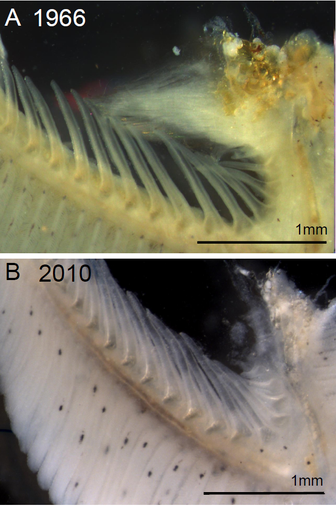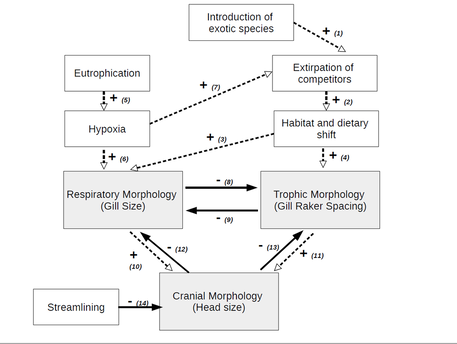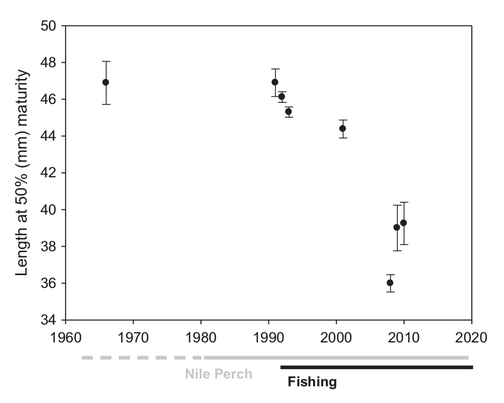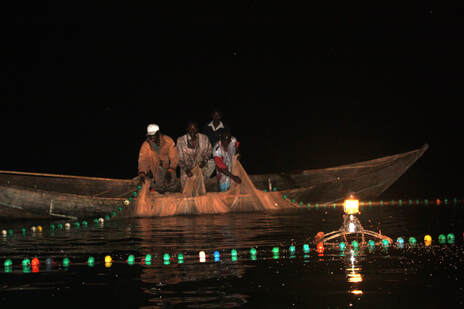How do piscivore introductions shape intraspecific trait variation?
Predator introductions undoubtedly impose strong selection on native prey, yet we still know relatively little about the extent, limits, pace, and potential consequences of any resulting trait changes in nature. Furthermore, introductions rarely occur in “pristine” ecosystems, but rather co-occur with other anthropogenic disturbances like harvesting, eutrophication, or impoundment. What happens when these stressors interact? What classes of functional traits are most likely to respond? What limits/constrains phenotypic responses? To what extent and in what contexts, can rapid phenotypic contribute to the persistence of species of socio-economic and/or conservation concern?
In my doctoral research, I tested for changes in morphological and life history life traits of R. argentea over the past 50 years – a period marked by the introduction of multiple exotic species, eutrophication, and the intensification of commercial fishing. I examined how simultaneous changes in multiple ecological parameters (increasing hypoxia, dietary and habitat shifts) over the past 50 years in Lake Victoria were associated with changes in three suites of neighbouring structures (respiratory, trophic and cranial) in R. argentea.
In my doctoral research, I tested for changes in morphological and life history life traits of R. argentea over the past 50 years – a period marked by the introduction of multiple exotic species, eutrophication, and the intensification of commercial fishing. I examined how simultaneous changes in multiple ecological parameters (increasing hypoxia, dietary and habitat shifts) over the past 50 years in Lake Victoria were associated with changes in three suites of neighbouring structures (respiratory, trophic and cranial) in R. argentea.
I found that contemporary R. argentea had significantly larger gills, likely representing a direct, adaptive response to more frequent bouts of hypoxia over time; but that this also resulted in correlated (and potentially maladaptive) changes in other structures, illustrating how trade-offs can constrain adaptation to multiple stressors.
Second, I found that predation from the introduced Nile perch and the onset of commercial fishing coincided with rapid and substantial life history changes, including increased reproductive investment and maturation at smaller body sizes :
Taken together, my results suggest that contemporary phenotypic change has likely played an important role in R. argentea’s persistence in the face of multiple stressors in Lake Victoria. The rate and direction of change in life history traits; however, raises concerns for the sustainability of the R. argentea fishery, now the most important (by mass) in Lake Victoria. This work provides critical insights for management of the R. argentea stock in Lake Victoria, and also broadens our understanding of global patterns of human-induced phenotypic change.
Publications related to this work:
- Sharpe, D.M.T. and Chapman, L. J. 2018. Contemporary phenotypic change in correlated characters in the African cyprinid, Rastrineobola argentea. Biological Journal of the Linnean Society, 124(1): 85-98.
- Sharpe, D.M.T., Low-Décarie, E., Langerhans, B. and Chapman, L.J. 2015. Little evidence for morphological change in a resilient endemic species following the introduction of a novel predator. Journal of Evolutionary Biology. 28 (11): 2054 – 2067. doi: 10.1111/jeb.12720
- Sharpe, D.M.T., Wandera, S.B. and Chapman, L.J. 2012. Life history change in response to fishing and an introduced predator in the East African cyprinid Rastrineobola argentea. Evolutionary Applications, 5(7): 677-693. doi:10.1111/j.1752-4571.2012.00245.x. (PDF)
Media coverage related to this work:
"Petit poisson sous haute surveillance." FQRNT Bulletin Génial, October 31 2012.
"The little fish that could." National Geographic News Watch blog, November 17 2011.
"Petit poisson sous haute surveillance." FQRNT Bulletin Génial, October 31 2012.
"The little fish that could." National Geographic News Watch blog, November 17 2011.
Collaborators:
L. Chapman, E. Low-Decarie, B. Langerhans, S.B. Wandera
L. Chapman, E. Low-Decarie, B. Langerhans, S.B. Wandera




